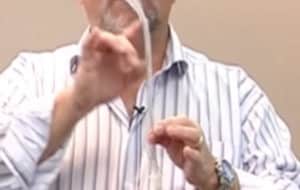1. Know When To Intubate
The Advanced Airway is not just about doing, but also about thinking. It may sound strange, but we should have an approach that allows us to quickly ascertain the appropriateness of intubation. My choice is when there is failure of ( whether this is now or imminent) of oxygenation and ventilation, maintenance of airway or airway protection.
then also ask the questions:
1. Will I be able to oxygenate and ventilate?
2. Will I be able to intubate?
3. Will I be able to perform a surgical airway if needed?
2. Know your drugs and equipment
Equipment
The basics are:
1. A Bag Valve Mask(BVM) to oxygenate and ventilate
2. The laryngeal mask
3. The curved blade laryngoscope- size 3 in most cases
4. The endotracheal tube(ETT). I use a size 7.5 for everyone then can change if I need to.
5. A stylette or introducer. I insert this into the ETT and curve the end like a hockey stick (see below)
6. A bogie if I need this.
7. A scalpel if I need to perform a surgical airway

Curving the end of the ETT can be very helpful. Remember that the trachea is anterior to the oesophagus and this allows us to intubate anteriorly.
This angle is the angle we see in the bougie. My reasoning, why use the bougie, when I can create a bougie-like device with my ETT.
Drugs
I really think of 4 main drugs to keep it simple. I will use others of course, but get good at using some agents.
KETAMINE
Currently my favourite drug for sedation and induction. In intubation, 1-2mg/kg will do the job. If you give it over a minute, the patient will slip into a dissociative state, if you give it fast, they’ll develop apnoea.
It’s a good analgesic, has some bronchodilator properties but it also is a central sympathetic stimulator. I’m starting to use it for all inductions. The only exceptions would be known allergy(very rare) and in hypertensive patients, as it may worsen this i.e., intracranial bleeds with very high blood pressures.
If I’m using it, I usually will give 1mg/kg ( say 70mg IV) and see what happens to the patient.
PROPOFOL
This is the staple. 1-2mg/kg, but beware as it can cause hypotension, especially in the elderly, or where the person is already hypovolaemic. It is an anti-emetic and anticonvulsant, but has no analgesic properties.
I like using this in head injury as it decreases intracranial pressure, that may be caused by intubation.
SUXAMETHONIUM/ROCURONIUM
I think I made my feelings on these two drugs clear in the blog ‘Roc Rocks, I’ll Miss You Sux‘ where I really looked at the literature and found that there is no reason not to use rocuronium for all cases. Sux has so many side effects, that it’s not worth using. The dose of Rocuronium is 1.2mg/kg of patient lean weight. At this dose it gives an onset similar to six. In terms of offset, we can always reverse Rocuronium. The biggest problem in a prolonged intubation is that the sux may wear off and make the intubation more difficult.
3. Buy Some Time
This is all about:
1. Pre-Oxygenation
2. Apnoeic Oxygenation
3. Delayed Sequence Intubation
4. Just Do It
This is about the intubation Technique:
1. Position: Aim(unless it is a trauma), to raise the head, so that the tragus of the ear aligns with the sternal notch. This is shown to make life easier.
2. Put the laryngoscope Blade in and sweep the tongue from right to left, so you have a clear view.
3. Look for the EPIGLOTTIS. This is the most important landmark
4. Place your blade into the vallecula- the space between the epiglottis and the base of the tongue. A small pull upwards in the direction of the handle of the laryngoscope, allows the vocal cords to fall into view.
5. When putting in the endotracheal tube approach it such that you are putting in the tube, coming upwards, so that the cords are always in view.
6. Secure your tube, cuff up. Note the length at the lips. Listen for equal breath sounds and look for at least 3-6 wave forms on capnography.
7. Think of post intubation care. Keep the patient sedated, beware to protect the eyes etc.
5. Have a Fallback
What will you do if you can’t intubate?
Try again, as long as the saturations don’t fall below 92%. You can ask someone else to try.
You can also try a laryngeal mask and if that fails try to BVM.
if you can ventilate and oxygenate the patient in this way, then there is no need to rush back in and try to intubate if this is difficult. You have time to wait for help.
If the patient isn’t ventilating, i.e.., you can’t oxygenate the patient, then a surgical airway must be considered. You can also think of needle cricothyrotomy.
I hope that helps you all.
Also read ‘My Rules For Getting The Airway‘.











I’m more than happy to find this website. I need to
to thank you for ones time due to this fantastic read!!
I definitely enjoyed every little bit of it and i also have you saved as a favorite to look at new information on your
blog.
continuously i used to read smaller posts that also clear their motive,
and that is also happening with this post which I am reading at this place.
Very good article! We will be linking to this particularly great content on our website.
Keep up the good writing.
Feel free to surf to my web site cannabis dispensaries-san
Its like you read my mind! You appear to know so much about this, like you wrote the book in it or
something. I think that you could do with some pics to drive the
message home a bit, but other than that, this is fantastic blog.
An excellent read. I’ll certainly be back.
Hey! I know this is kinda off topic nevertheless I’d figured I’d ask.
Would you be interested in trading links or maybe guest writing a blog article or vice-versa?
My blog covers a lot of the same subjects as yours and I think we could greatly benefit from each other.
If you are interested feel free to shoot me an email.
I look forward to hearing from you! Great blog by the way!
excellent submit, very informative. I’m wondering why
the opposite experts of this sector do not notice this.
You must proceed your writing. I am confident, you have a great readers’ base already!